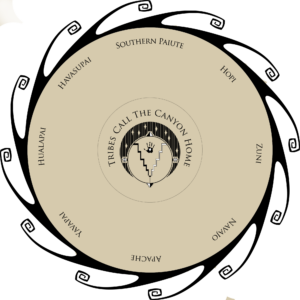“We are still here. We are our ancestors. We will not be forgotten.”
(Quote from Breath of this Land video)
The story of Grand Canyon cannot be told without acknowledging and celebrating the importance of the canyon and the river that runs through it to the native peoples of the southwest. Connections to the canyon run deep in native cultures, with numerous tribes tracing the origin of their people – their literal emergence into this world – to specific locations in the Grand Canyon.
Elements of westward expansion and public land acquisition are difficult to bear. Native peoples were wronged, and these 11 tribes are no exception. But they are still here – on their land, living their stories. All inextricably linked to the Grand Canyon. Only through acknowledging and accepting this troubling history can we move forward and work together to become better stewards of the canyon and its surroundings.
A prime example of progress in this area is the newly designated Baaj Nwaavjo I’tah Kukveni – Ancestral Footprints of the Grand Canyon National Monument. This monument designation represents a promising step towards healing amongst neighbors and fostering a positive co-stewardship of the land in which so many have a stake.
“We have planted a seed, and with care and attention, it will grow and flourish, bolstering the vitality of our region, supporting our nation’s prosperity and serving as a touchstone for our connection to the globally connected ecosystems of which it is a part.” – Randy Moore, Chief of the U.S. Forest Service
The renaming of an important cultural site that has become a popular backcountry stopover in Grand Canyon National Park also represents a step in the right direction. In November 2022, the U.S. Board of Geographic Names voted unanimously to rename Indian Garden to Havasupai Gardens. Future visitors to this well-known place along the Bright Angel Trail will now be more aware of the ancient ties that the Havasupai people have to the land. Read more about the name change in Grand Canyon National Parks’ Press Release on the event.
Learning stories from the tribes of the Grand Canyon region of their deep connection and respect for the canyon and its waters reminds us to work together to protect the physical landscape and its cultural and spiritual significance. During your river trip, you’ll enjoy the spectacular scenery and the thrill of whitewater rapids as you travel the depths of the Grand Canyon. Awe and wonder come easily. As you play in the waterfalls, explore ancient ruins, and gaze up at the night sky beyond the canyon walls, take time to consider the original caretakers of this magnificent place, the native people who have called the Grand Canyon home since time immemorial.
There’s no better way to learn the stories and cultures of these tribes than to listen, read, or experience them directly. We encourage you to visit the resources below and develop a deeper understanding and appreciation for the connection between the tribes of the Grand Canyon and the region you’ll be traveling through.
- The 11 Associated Tribes of Grand Canyon. Grand Canyon National Parks’ acknowledgment and introduction to the people who call the canyon home.
- Grand Canyon Speaks Podcast – A fantastic podcast series that airs interviews with artisans from the 11 associated tribes.
- Save the Confluence – A grassroots, Navajo-led community group organized in response to the recent threats of development on sacred land in the canyon.
- Grand Canyon Trust – A local non-profit that is “safeguarding the wonders of the Grand Canyon and the Colorado Plateau, while supporting the rights of its Native peoples.” We recommend checking out their Voices of the Grand Canyon page.
- Books – We have a few books in our store that share a deeper understanding of various tribes.
Places to consider visiting if you’re in the area during the days surrounding your trip:
- Museum of Northern Arizona – Located in Flagstaff, it’s worth a stop if you have some time before/after your river trip. They host classical exhibits as well as a dynamic calendar of events throughout the year.
- If you find yourself at the South Rim, visit the Desert View Inter-tribal Cultural Heritage Site. While technically still in development with involvement from all 11 tribes, the goal is to “…address the historic inequities faced by Native Americans through new pathways for cultural and economic opportunities to determine a new thriving future.” They often have local tribal members providing various art and culture demonstrations.
- The Hopi House at the South Rim Village is a go-to for authentic arts and crafts made by local native artisans. The building itself is a stunning recreation of a traditional Hopi pueblo.
- Navajo Bridge Interpretive Center – Located near Marble Canyon. Outdoor exhibits, bookstore, and the potential to see California Condors.
Websites of the 11 Tribes:

